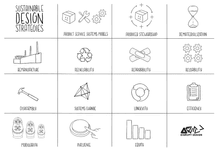
Quick Guide to Sustainable Design Strategies

It is time for designers to set our sights beyond sustainability and consider regeneration. Sustainability is an important concept in a time of widespread environmental destruction. It has made us aware that our planet’s resources are finite, and helped us envisage practices to sustain our current resources. But on its own it does not fix what is... See more
space10.com • Regenerative by Design
The Circular Economy—Designing for longevity and reuse of materials beyond the first use
Damien Lutz • The life-centred design compass
- Might a circular economy afford new ways of collaborating, sharing and commoning resources?
- What would everyday life be like within a truly circular economy?
- What are some of the design challenges in transitioning from a linear economy to a circular economy?